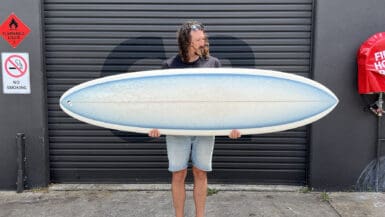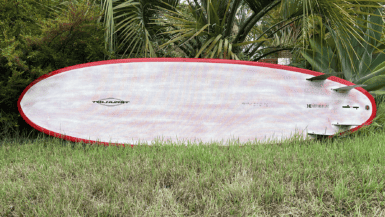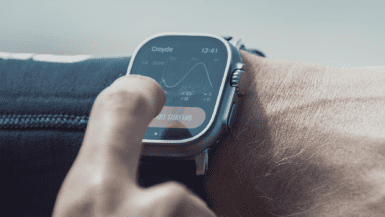Looking to add a new mid length surfboard to your quiver? Here’s my hands on review of the Slater Designs Boss Up by Kelly Slater and Dan Mann
The new Slater Designs Boss Up Mid Length promises a well rounded board that will handle pretty much everything you can throw at it – with paddle power and performance all rolled into the big brother of the popular S Boss.
But does the latest Kelly Slater surfboard deliver?
Well here’s my full review and whether you should add this to your quiver…
REVIEW: Slater Designs Boss Up Mid Length Surfboard
Contents
Unfortunately I’m out of the water at the moment with an achilles injury, but given the amount of interest in this board I wanted to get a review out for you guys ASAP!
So I roped in my buddy Adam and got a fresh Boss Up under his feet for a few super fun days around Byron Bay. Adam loves longboards and mid lengths so he was the perfect test pilot, as well as riding boards in similar dims to myself – which meant I can still use the board when I’m back in the water!
He’s been super blunt with his feedback and helped me answer all the questions you’ll probably have about the Boss Up and what it’s like to surf!
Who’s It Aimed At?
When it comes to who the Slater Designs Boss Up is aimed at – it’s certainly a mid length surfboard for the masses.
For lower end surfers, the longer models and easy paddle power will keep your wave count high and the fun factor too, whilst more advanced surfers are going to love the performance and range of swell size it can be used in.
Although this isn’t going to be a mid length for beginner to high end beginner surfers (I’d recommend something like the Cape Collective Midway or the Thunderbolt Moe if you fit into that category), for those who are cruising on green waves and starting to progress those turns and upwards, the Boss Up will feel great underfoot.
And the fact it’s under Kellys feet shows that even professional surfers are going to enjoy this board heaps too in pumping swells!
Dan Mann has a history of creating really user friendly boards which also pack in great performance ability too – such as the Dominator 2 and the Mashup – and the Boss Up is another super fun, user friendly board to add to the growing list.
Board Breakdown & Dimensions
The Firewire Boss Up sits above the standard S Boss in terms of length and dimensions, starting at 6’6, running right through to 7’6.
 Shaper Dan Mann recommends around 13 litres more than your standard daily driver shortboard, but also mentions that because of the clever ways they’ve wrapped the volume with performance, dialling in your perfect sizing isn’t something you should loose too much sleep over!
Shaper Dan Mann recommends around 13 litres more than your standard daily driver shortboard, but also mentions that because of the clever ways they’ve wrapped the volume with performance, dialling in your perfect sizing isn’t something you should loose too much sleep over!
- 6’6 x 20 x 2 13/16 – 39.50L
- 6’8 x 20 1/4 x 2 7/8 – 40.77L
- 6’10 x 20 3/8 x 2 15/16 – 42.98L
- 7’0 x 20 7/16 x 2 15/16 – 44.34L
- 7’2 x 20 1/2 x 3 – 46.44L
- 7’4 x 20 7/16 x 3 1/6 – 48.42L
- 7’6 x 20 5/8 x 3 1/8 – 51.4L
Now having looked at the dims, and the types on conditions I wanted this board for I was torn between the 7’0 and 7’2.
Honestly I think if you go smaller than that, you’re basically buying an inflated shortboard rather than a full mid length – and with the medium entry and exit rocker, that added bit of length through the middle was going to maximise the paddle power of the board.
In the end I opted for the 7’2 – it has similar dims to my Broken Arrow (one of my favourite mid lengths) so it should tick all the boxes for my requirements and the types of waves I’ll be surfing on it – mainly point breaks on the East Coast of Aus. And test pilot Adam also has a Broken Arrow in the same dims as me, so it seemed like a safe option for everyone.
Plus I’m a firm believer that foam is your friend, and at 185cm and 83kg a bit of extra foam is always welcome!
One of the first things Adam and my buddy Andy had to say about the board was how much the tail resembled the TJ Pro longboard they both ride and love.
Given that this is one of the most popular longboards by shaper Dan Mann this isn’t a big surprise and you can tell Dan has merged his extensive knowledge of performance shortboards and longboards together for the Boss Up.
Fin Setup
The Slater Designs Boss Up comes with a 5 fin setup – allowing a few options in terms of the fins you can run with it.
![]()
 As with all the Firewire and Slater Designs boards, these are now only available with Futures fin boxes.
As with all the Firewire and Slater Designs boards, these are now only available with Futures fin boxes.
During the development of this board the Slater Endorfin fins were the constant according to Dan Mann – with the quad fin set being the go to for Slater and everyone involved in the creation of the board, so that would be the obvious choice if you need a fresh set of fins for it.
In a few of his videos Kelly has also said he loves the board as a twin with trailer in smaller conditions, whilst Kevin Schutlz has been using is as a thruster a lot as well for even more pivot in his turns.
Unfortunately I couldn’t get my hands on the Endorfins for testing this one out (super low stock on large sets in Australia at the moment!) but I ran it using the Futures Firewire fins as a quad and it went great. I did consider chucking in the Machado Split keels but after a quick chat with Dan Mann he recommended the Firewire set.
Even though my buddy Adam hasn’t ridden quads for a long time, he had no issues throwing it around with 4 fins and was finding tonnes of speed down the line.
So my advice – strap in your favourite set of quad fins to get started and then play around!
Ibolic Construction
Currently the Boss Up comes in Firewires new Ibolic construction – which has a really good flex pattern and is certainly more comparable in feel to a standard PU board versus their lighter, but stronger Helium tech.
Personally the Ibolic isn’t quite as durable as Helium or Thunderbolt tech though, and although there are only light presuure marks on the deck after a few days of testing, the Ibolic is certainly more prone to pressure marks than the other constructions.
Check out this link for more info on the Ibolic construction by Firewire
It does look like it will also be available later in the year in Volcanic construction – which is definitely more robust – so if you’re not in a rush, it might be worth holding out for that release if durability is a key factor in your decision.
Ideal Wave Conditions
From everything Adam tested it out in, plus the epic footage the likes of Kelly Slater, Kevin Schultz and Michel Bourez, the Boss Up seems to fly in all conditions.
From your average day at a beach break, through to pumping Tahiti and Hawaii – whether you’re chasing turns or barrels.
The term “one board quiver” does get thrown around a lot but the Firewire Boss Up certainly throws itself in contention for this label and is definitely a solid shout if you’re looking for a single travel board that can handle a huge cross section of conditions and swells.
The only thing I’d say the Boss Up isn’t going to be great in, would be super bumpy and windy conditions. The extra lightness of the epoxy construction don’t lend themselves to heavy wind and chop, so keep that in mind.
Boss Up vs Mid 6
I know one of peoples first comparisons for the Boss Up is going to be against the Harley Ingleby Mid 6.
With the split between Firewire and Thunderbolt, it was obvious that Firewire needed a new mid length surfboard in the lineup and the Boss Up definitely fills that gap.
Having spent a lot of time surfing the Mid 6, Adam is also well placed to compare the two boards and his feedback was that he felt the Boss Up had the same high end performance (check out the video below for its big wave capability!), but most importantly also had the advantage of more paddle power, and small wave performance too.
We did also sit both boards next to each other to compare and a couple of things we noticed straight of the bat were the fact the Boss Up was far more pulled in at the nose, whilst the Mid 6 seems more tapered at the tail. The wide point of the Boss Up also dat further forward than the Mid 6, which is one of the contributing factors on its forgiveness and small wave prowess.
So for those in the lower levels of progression it’s going to be far more forgiving and arguable has a more well rounded level of performance in wave size and conditions.
The other big thing to take into consideration is the price. Firewire have certainly priced the Boss Up aggressively – ranging from $1200-1300 depending on the sizing, which is considerably cheaper than the $1600-1700 price tag of the Mid 6 range.
What’s It Like To Surf & Final Verdict
One of the first things Adam said to me was that the Boss Up was insanely easy to paddle, in fact he said that he hadn’t actually missed a wave that he’d paddled for the entire session.
And when you’re surfing in busy breaks, paddle power is a huge must have for any board you’re riding.
But it also backs up that wave count with performance too.
That long, straight rail line allows the board to maintain a whole heap of speed, especially when combined with a quad fin setup which will give even more drive and control.
Yet, with the pulled in, rounded pin tail, it’s super easy to manoeuvre, something which is made even easier by the pronounced “spine” from the double concave running most of the length of the board, allowing it to “roll” easily from rail to rail.
Even before Adam mentioned it to me, as I was filming footage I thought it looked really good under his feet and looked super smooth, easily flicking it around in the pocket and cruising down the line.
Trimming easily through the smaller, dead sections but lightning fast and controlled on the bigger set waves, he made short work of a variety of conditions. Even managing to drift the tail a few times, which is pretty impressive on a board this length with a 4 fin setup!
Essentially it’s fast, smooth, easy to paddle and can handle pretty much everything you can throw at it – from thigh high mush through to over head and hollow.
What’s there not to like about that?!
Certainly one it look like I’ll be keeping in the quiver…even though Adam has already tried to convince me to sell it to him, which should surely be the biggest seal of approval following his test days on it!






Leave a reply